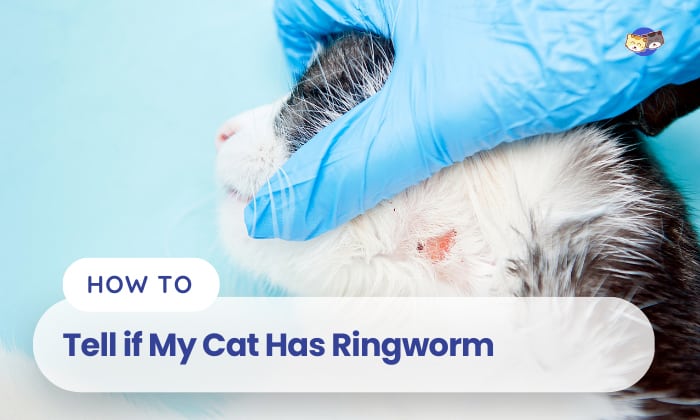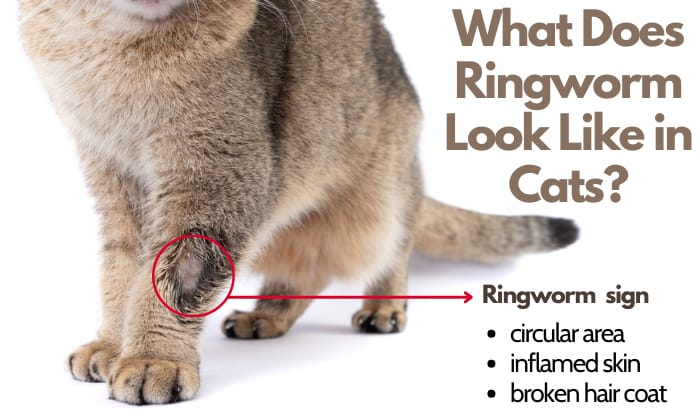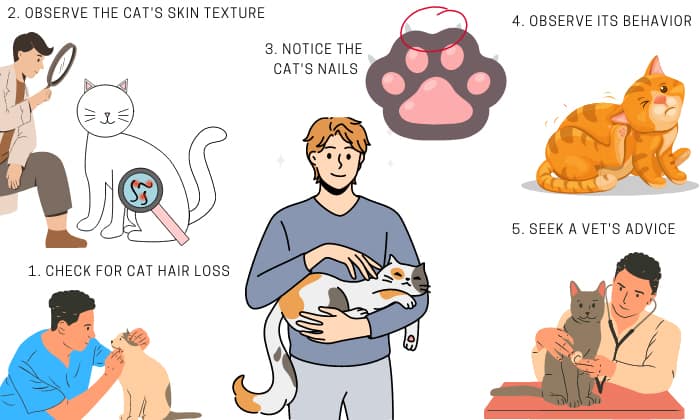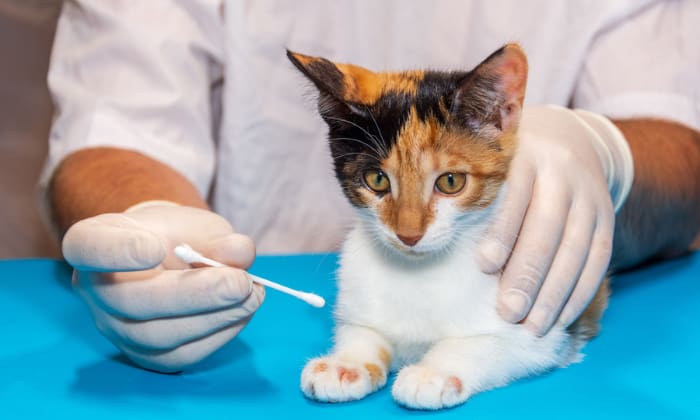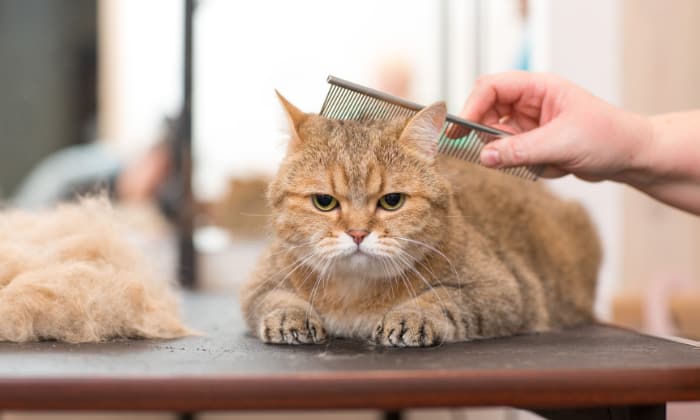Also known as dermatophytosis, ringworm directly affects your cat’s skin, nails, and fur. This type of infection is one of the health issues that cats face. So, as a cat owner, it is crucial to stay on top of your pet’s good health. And a common health question you may ask yourself is, how to tell if my cat has ringworm?
There are visual signs of this infection on your cat’s skin and nails. Read below to know if your cat has this fungal infection, the measures to take, and other helpful tips for treating and preventing it.
Table of Contents
What Does Ringworm Look Like in Cats?
The early stage cat skin ringworm may be difficult to detect and may appear in different ways. The most common sign you can find must be the “cigarette ash” patches deep in the cat’s fur.
Here are the most common visual signs of ringworm in cats:
- The hair loss area is often circular, showing the skin in these patches to be red and inflamed.
- The remaining hair coat around the wounds appears broken and bristly.
- Ringworm can also cause nail infection, with a cat’s claws turning brittle and even deformed.
- The skin color might change slightly as the infection progresses.
5 Common Signs to Tell if My Cat Has Ringworm
Follow these steps to determine ringworm in cats:
1. Check for cat hair loss
The ringworm fungi will cause hair loss in cats. Circular bald spots are common indicators to look out for. Also, the pet’s remaining fur from the ringworm cat hair loss symptom may have a brittle texture to it.
2. Observe the cat’s skin texture
Check the texture of the cat’s bald spots. Scaled texture or inflammation are indicators that a bacterial infection is happening. In some cases, the bald spots found on the cats may have a scaly texture.
Ringworm above the cat’s eye may be another common symptom. Because of the infection, your pet may start scratching this area. And excessive scratching might leave open wounds there.
3. Notice the cat’s nails
Ringworm may also cause your cat’s nails to be rough. Nail deformity may also occur with this infection.
4. Observe its behavior
Notice if your cat is constantly scratching. Because of the inflammation, cats would often scratch these bald patches. This may lead to skin lesions.
5. Seek a vet’s advice
The best bet for ringworm treatment for cats is to seek out a vet for an official diagnosis and medication.
You can bring a sample of the cat’s skin lesions or a piece of its fur surrounding the scaling area to the vet to be tested using a fungal culture test kit. Some might use Wood’s lamp’s ultraviolet light to identify the infection.
Tips to Treat Ringworm in Cats
You will not be able to give your pet the treatment it deserves without going to the vet. Please consult with a vet to get the correct diagnosis.
Have these tips in mind when treating your cat’s ringworm:
- Consistency is key: Always make sure to follow your veterinarian’s instructions. If needed, take note of the dosage schedule and other special requirements you must follow during the treatment period.
- Know The Systemic Treatment: Your vet may prescribe systemic treatment to counter ringworm in cats. These anti-fungal may take up to 6 weeks of administration, so it would be important to note down the proper dosage and schedule.
- Know The Topical Treatment: Topical treatments commonly refer to anti-fungal cream or shampoo that needs to be applied on a cat’s skin. Be extra careful when applying this treatment, for a cat may lick or scratch affected areas after application.
- Properly Decontaminate Your Pet’s Area: If possible, dispose of all objects that are likely sources of ringworm in your cat’s area. Removal of pet hair in your home is highly suggested, and chemical disinfection may be needed to take out dermatophyte spores.
- Petting a Cat with Ringworm: Care and affection are still important during the treatment process. But please ensure that both you and your pet are disinfected to avoid any spread of ringworm.
- Avoid Unnecessary Treatments: Over-the-counter medication and home remedies may derail proper treatment. Always stick to what your vet suggests.
How to Prevent Ringworm in Cats
Follow these important guidelines to prevent ringworm:
- Do not let your cat roaming freely outdoors: You can let your cat play outside, but do not let it go freely in the neighborhood where the environment might contain fungal spores from other animals.
- It Pays to Have a Clean Place: Always ensure your home or your cat’s area is free from dirt. Spores may build up in dirty areas and may quickly infect your pet.
- Practice New Cat Isolation: Bringing a new cat into your home may open up risks of ringworm infection. Prevent this by isolating the new cat and performing a fungal culture to check for potential infection.
- Proper Cat Grooming is a Must: Aside from keeping your place clean, your cat itself must be free from dirt as well. Regularly groom and bathe your pet to avoid any possible build-up of spores.
Also, make sure you clean the grooming tools thoroughly before and after the procedure.
Frequently Asked Questions
How do indoor cats get ringworms?
The main cause of ringworm is spores. These ringworm spores can be indoors, such as in carpets or other furniture.
Can ringworm be passed on to other cats?
Yes. Ringworm is highly contagious. It is highly suggested a cat during the treatment period, especially if you have other pets or people in the house.
How does a veterinarian diagnose ringworm?
Ringworm can be easily confused with other diseases. A vet can properly diagnose ringworm using ultraviolet light technology to check the bald patches on a cat. Another way to check for ringworm is by fungal culture, where a cat’s hair will be observed using a microscope for dermatophytes.
Is there a special way to treat ringworm in kittens?
Topical treatment is the suggested treatment procedure for kittens. Systemic treatment (oral medication) may be hard for young cats.
Conclusion
How to tell if my cat has ringworm is a common question asked by cat owners. But it can be effectively managed by taking the necessary steps, such as a proper diagnosis (knowing what a ringworm can look like on a cat), treatment, and prevention.
Stay patient and stick to the treatment plan for your cat to return to their healthy and happy self!

I am Amy Sawy, a Doctor of Veterinary Medicine (DVM) graduate from the University of Kansas. y husband, Dr. Plummer, and I own a veterinary clinic in Phillipsburg, Kansas. In addition to my professional background, I am a devoted pet owner myself, with a household that includes dogs, rodents, and most notably, cats – a total of five felines in my home.
In 2020, I joined an organization as a professional writer, leveraging my experience and collaborating with my team to deliver the most valuable information for your cat’s care.


